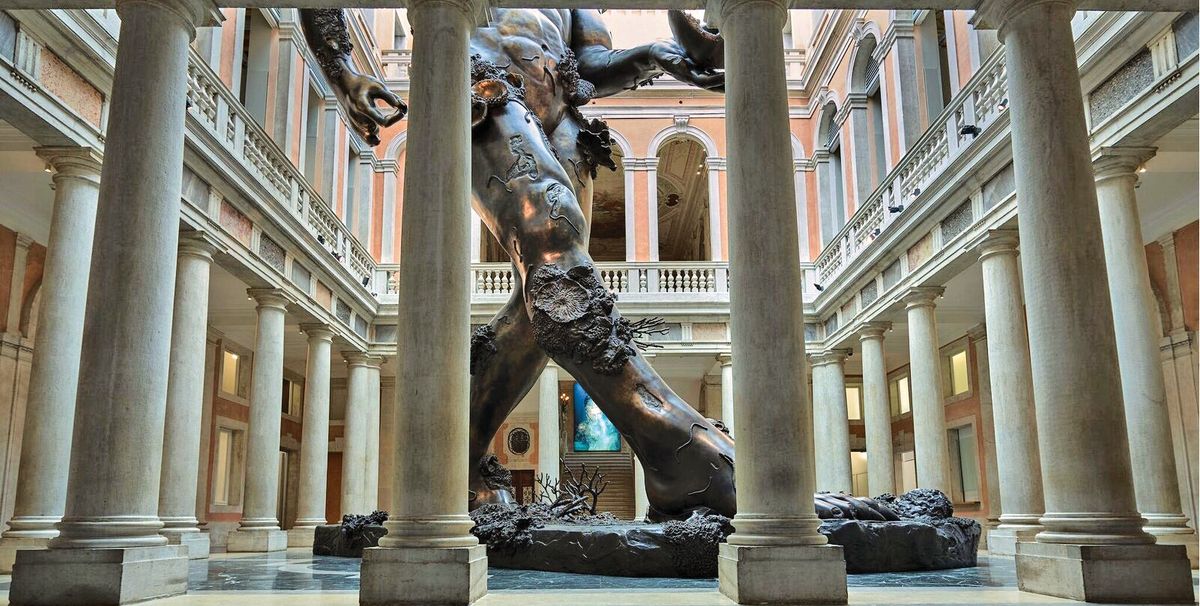Damien Hirst’s two-venue extravaganza in Venice, Treasures from the Wreck of the Unbelievable (until 3 December), has been widely interpreted as an attempt by the former bad boy of British art, now millionaire celebrity, to revive his market in the wake of weakening sales and critical panning in recent years.
Hirst is not the only one hoping for a bounce-back. Indeed, the list is long of investor-collectors holding his work, starting with the New York property developer Aby Rosen, Chicago collector Stefan Edlis, the Nahmad and Mugrabi families and—most significantly—Christie’s owner, François Pinault, who has provided his two Venice museums, the Punta della Dogana and the Palazzo Grassi, as the show’s venues.
There is a lot riding on the show from a commercial, let alone critical, perspective. Hirst’s prices slumped after his self-orchestrated Beautiful Inside My Head Forever sale at Sotheby’s in September 2008. Back then, the “spin” painting Beautiful Mider Intense Cathartic Painting (with Extra Inner Beauty) fetched £668,450; this year, it made just £449,000 at Phillips.
The pieces for which Hirst gained early fame confront life and death in bald if poetic terms. In contrast, his latest series is driven by a fantastical backstory about a shipwrecked art collection, for which he has produced dozens of sculptures, including monumental ones, in a range of precious materials from malachite to gold and silver.
The show, curated by Elena Geuna, has been almost ten years in the making, and the artist told the BBC it cost between £50m and £100m. Various sources have been rumoured for funding, including Pinault himself and the casino magnate Frank Fertitta III—who, according to three sources, has acquired a number of works.
In the run-up to the opening, collectors were targeted by Hirst’s commercial representatives with images on tablets, while a teaser video was sent out to the press. The show was advertised on Venice’s ubiquitous vaporetti (waterbuses) during the opening of the Biennale.
While Hirst clearly means to make an artistic statement, the works are all for sale, in editions of three plus two artist’s proofs. The backstory conveniently allows three versions for each item (one supposedly found on the imaginary ship, one cleaned up by conservators and a modern museum model of the original). In total, there are 15 versions of each of the 189 works in the show—with vitrines containing small “artefacts” counting as single pieces, and priced at $1m. Prices reportedly range from $500,000 to more than $5m, and $14m for the bronze version of the scaled-up sculpture, Demon with a Bowl, that dominates the atrium of the Palazzo Grassi and was made in resin especially for the building.
So, can the show revive both Hirst’s market—which has not recovered its 2008 auction peak of £10.3m, for the formaldehyde vitrine The Golden Calf—and his reputation, which was fairly hard hit after his 2009 show of Blue Paintings at London’s Wallace Collection? Critical reactions to Treasures have ranged from damning—“a spectacular, bloated folly, an enormity that may prove the shipwreck of Hirst’s career”, said the Daily Telegraph—to almost ecstatic: the Guardian called it a “titanic return to form”.
As for sales? The artist’s galleries offer the usual positive spin, but it is difficult to evaluate apart from a few well-publicised instances, such as a purchase by the Shanghai-based collector Qiao Zhibing. The dealer Jay Jopling of White Cube has been upbeat, sharing privately that works are “going fast”. Gagosian’s spokeswoman said: “The exhibition has been extremely well received”, but did not wish to comment on prices or sales. “Mr Pinault will probably acquire some of the pieces from the exhibition,” said a spokesman for the French collector, who declined to give further information.
Some of the likeliest buyers, however, have hung back. “We haven’t bought anything so far,” said Helly Nahmad—whose family has significant Hirst holdings— speaking at Art Basel in June. “We are waiting to see the show when we go to Venice.” However, most art world players I spoke to said they had the impression that sales were going well, although one commented: “Strangely, nobody admits that they have bought the work, except the usual two or three people.”
At Art Basel, a solid gold skeleton, identified by a White Cube staffer as a “precursor” to the Venice works, entitled Cupid’s Lie (2008), was on offer in three editions at $3m each. There were no takers during the two VIP days.
Update: After the fair, White Cube said that one of the pieces had sold.
• For more on this show, see Breasts, bears and Barbie: what you might have missed in Hirst's Venice show


